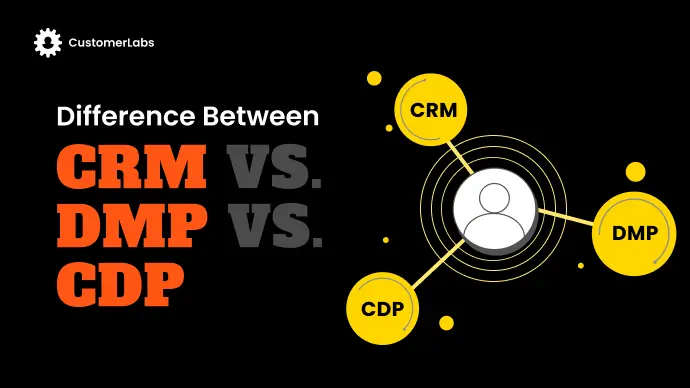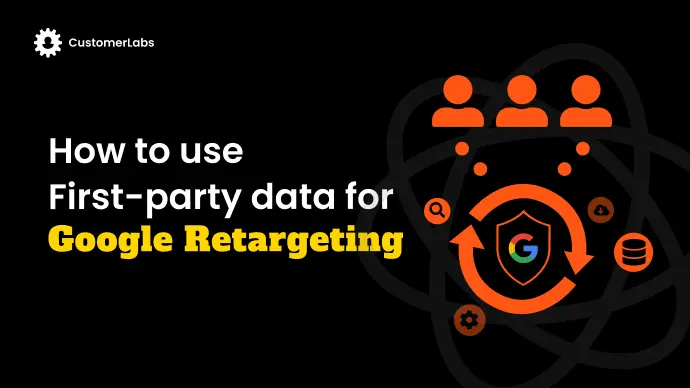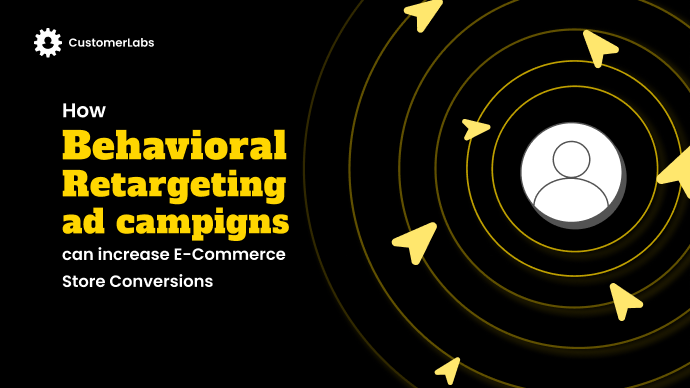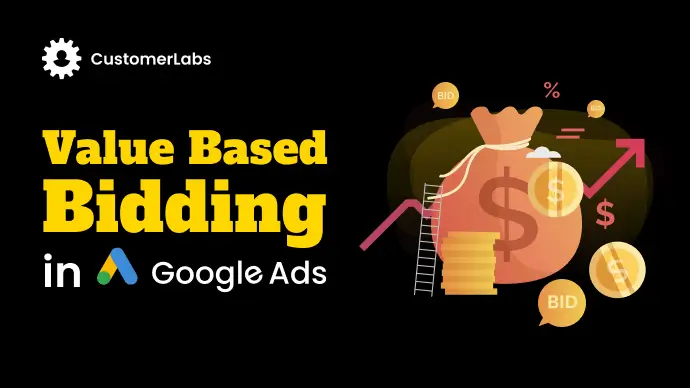
The recent crucial update to the bid strategies by Google is ‘The Value Based Bidding‘. Until now, most marketers were going with the traditional bidding strategies to bid for a conversion action. Now is the right time to make a shift to bid for value to increase your conversion value and profit margins.
[You can use the table of contents on the left, and navigate to the specific sections such as Best practices of Value Based Bidding, or to understand how it works, or even to check the feasibility for your business, if you wanna skip the intro.]
Value based bidding, Performance Max campaigns, Advantage+ campaigns, smart bidding, etc., are all the result of ad automation powered by AI & machine learning. It is the perfect time to adopt these strategies to grow your business. Especially, PMax campaigns in Google Ads.
Let’s see how value based bidding strategy will actually work for you. By the end of this blog, you understand and get an idea on
- What value based bidding is
- How it works
- How to run value based bidding strategies in your Google Ads campaigns
- Leverage full potential of value based bidding to enhance your ad campaign performance
- Recommended tips & best practices from experts
- Use value based bidding strategy for your business model
Finally, you will understand in detail about value based bidding and utilize maximize conversion value bidding strategy to achieve higher revenue.
What is Value Based Bidding?
Value based bidding is the bidding strategy that focuses on the value of conversion rather than number of conversions. That means your ad campaigns will focus on quality rather than quantity. Value based bidding strategy will consider stage specific conversion value rather than simply assigning a value to the final conversion stage.
This smart bidding strategy will optimize your ad campaigns towards maximum conversion value.
For example, products A, B, C, D & E bring value of $5, $10, $17, $18 & $23 to your business respectively. Now, bidding $10 for product A and product B does not make sense as it is not profitable. Whereas, if you bid $10 for product E, it gives you a ROAS of 2X. (If this is confusing, read on to understand clearly).
Earlier, when you use pay-per-click bid strategy, every single click is considered as final conversion, and all the clicks cost you the same irrespective of what value they provide.
Watch this video on setting up data strategy for Value Based Bidding
What changed now in VBB?
With AI & machine learning venturing into the ad platform automation, bidding has gone to a next level.
Now, you can actually assign values for various stages of conversions by differentiating the most valuable conversion and the least valuable conversion. You should assign a higher conversion value to the stages closer to the final conversion. The final conversions are more prominent compared to the first stage of your customer journey.
Therefore, now you can assign the higher value to the final conversion, and lower value to the mid-stages of the conversion. For example, landing on the page from the ad can be bid for low price, and final purchase can be bid for high price.
When you feed conversion value data to Google Ads, it will bid high for those high value conversions. This is the reason behind Google recommending you to “keep your budgets high” for value bidding strategy.
You can leverage value based bidding when you share the right data with Google such as:
- The value a specific conversion action brings to your business
- The clicks that did not convert
- Entire customer journey across online and offline channels
- Customer’s final value (customer lifetime value or order value)
Quick notes on how you can make value based bidding work for you:
1. Train the Ad platform with better data
Google Ads needs better understanding of which users are valuable and for that, you need to share high-quality first-party data. You can do that using – 1. Website conversion tracking; 2. Offline conversion tracking from your CRM.
When you do this, assign different values for different stages of the user in your CRM and Website.
For example,
- all the users who just visited your page and viewed it, are of $30 worth
- those who submitted the form are of $50 worth
- those who made the purchase are of $99 worth
- Each lead in the opportunity stage has a different opportunity value,
- First time users are of low value and repeat customers are of high value
Note: After the launch of Google consent mode v2, it is mandatory that you share your first-party user data with Google by appending the consent parameters. Else Google will not use that data.
When you sync this first-party data with Google Ads along with the conversion value, the algorithms will be in a better place to understand your users and the value they provide. This optimizes your value based bidding campaigns.
Using CustomerLabs 1PD Ops, you can store your first-party user data along with parameters such as the GCLID, WBRAID, along consent details, that help ad algorithms identify the user better and target them.
2. Optimizing the algorithm with the right value to bid at right time
It is already established that you would need to assign values to your users and the stages they are in. So how do you do that? If it is the final conversion value, you have the value of the product or service. But what about the other stages?
An estimated value approach can be chosen to assign the value to your users. Using the conversion value calculator or just by making a calculation as to which user might return how much value. In addition to that, you can assign same value to every user (if you think that works) or assign different value to different users depending on their intent and interaction with your brand.
Finding what value to assign through an example
For example, for one user the transaction value might be worth $80, while for the others it might be $350.
You can assign values using the profit margin method. Here’s how it is. Let’s say the average order value is $7000 making a profit of 30% and the lead data shows your conversion rate is 25%. Now, the conversion value would be ($7000*30%*25%) = $525.
Using the Lifetime value mode. Let’s say the user contributes in total $12000 in their lifetime to your business. Then for the same profit margin and conversion rate, the conversion value would be $900.
Sending the data back at right time
Just as how important assigning the value to the user is, sending it in almost real-time is essential. This allows real-time optimization of your campaigns with the value for the value based bidding.
How Value Based Bidding Works?
Assume that you want to advertise on billboards across the country. Now, you would spend high on those advertisement spaces (let’s say New York City) which would get you a higher profit margin and spend less on those spaces (let’s say Providence village, Texas) that give you a lesser profit margin. This is exactly how value based bidding works.
The algorithm will understand the conversion value you have sent to Google Ads. Accordingly, it will bid more for the conversions that offer you higher value. Similarly, it will bid less for the conversions that offer you less value.
The algorithm trains itself by using historical performance of your ad campaigns, audience signals (both individual & cross-signal effects) and the first-party data that you input to the ad platform. It combines various audience signals and optimizes your ad campaigns to offer you the best possible ROAS. In the process it will also train itself on what works best for you and what does not.
In the value based bidding, Google Ads gives you the following two bid options:
- Maximize Conversion Value
- Target ROAS (tROAS)
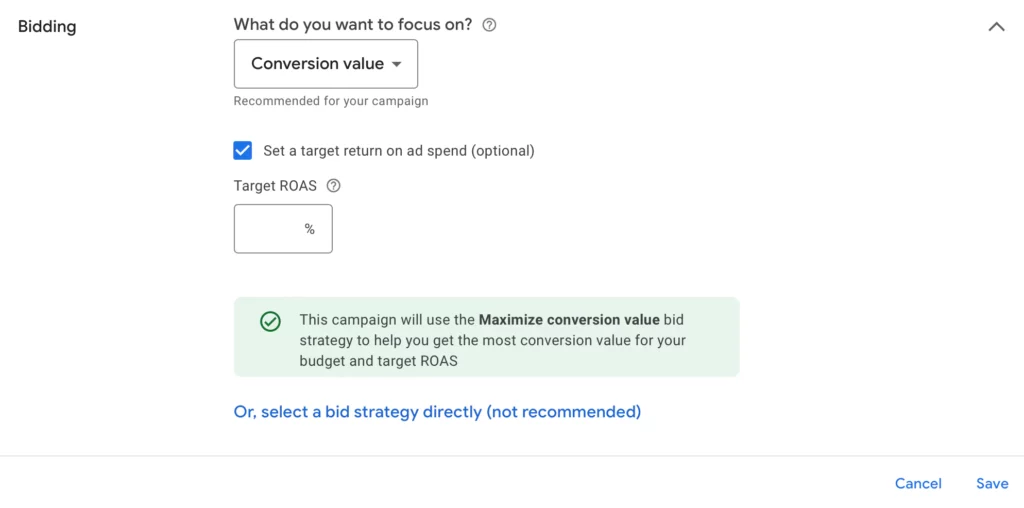
By default, when you try to change the bid strategy and check for all the bid strategies available, it shows you only maximize conversion value and conversions. Only after you choose the maximize conversion value option, it shows you the target ROAS bid strategy option. You can either set the target ROAS or just go with maximize conversion value by default based on your strategies.
Why to use Value Based Bidding | The Impact on Advertising
When you use value based bidding, you automatically see an increase in your conversion value and your overall profit margins. Recent study shows that there’s a 14% increase in the conversion value for those who shifted from tCPA to tROAS.
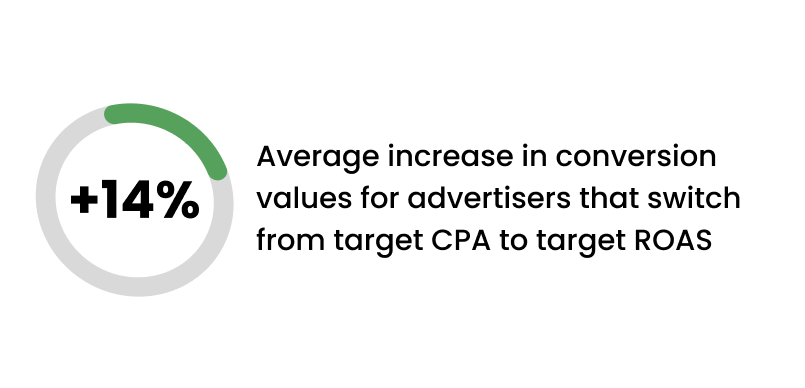
Now, to make the effective use of maximizing conversion value bid strategy, you should adapt the strategy into your performance max campaigns. But why should you do it?
Why use Value Based Bidding in Performance Max:
Firstly, performance max campaigns optimize the bid value in real-time without any delay to achieve the objective selected. Secondly, it runs its campaigns on all spaces and optimizes your campaigns in real-time. Therefore, your ad will be shown at the right time at the right space.
Benefits you see:
When you use value based bidding in Performance Max Campaigns, the following happen:
- Higher Conversion value rather than more conversions (Quality over Quantity)
- Equip the automated bidding process with conversion values
- Automated bid value adjustment in real-time based on the conversion values
- Capture right audience signals and reach out to high prospective similar audiences
- Optimize the campaigns in real-time
- Drive your ads towards a specific objective (Conversions, Leads, Traffic, etc.)
- Higher conversion value for the best bid amount across all the channels of Google
- Offer personalized advertising based on the user’s preference with the combination of ad assets provided & real-time bidding
- Full control on your ROAS
- Automatic control over your budgets
When you use value based bidding in Performance Max campaigns, you spend only on the people whom you think will get you an ROAS of let’s say 150% (your desired) across all the six channels of Google.
Therefore, when you use value based bidding strategy in PMax campaigns, it proves to be very effective.
Note: It is recommended to have higher budgets to run these automated campaigns under smart bidding to see desired results.
You can also use value based bidding in Google Ads for the following campaigns that are equipped with conversion tracking:
- Search ad campaigns
- Shopping ad campaigns
- Display ad campaigns
- Video action campaigns
Conversion value based smart bidding works better with campaigns that optimize real-time as the conversion values can be synced in real time. Therefore the ad spend is optimized for the required target – either the maximize conversion value or target ROAS.
How is Value Based Bidding different from the other Bidding Strategies?
In general, there are two bidding strategies that you might be using:
- Target CPA bidding strategy
- Maximize Conversions bidding strategy
Now, how is value based bidding strategy different from the above?
Here’s the below table that puts forward all the available bidding strategies and how they are different from each other.
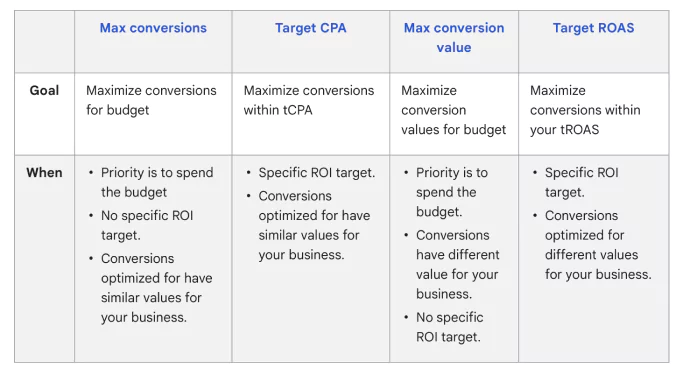
How Max Conversions / tCPA bidding works?
In the target CPA (tCPA) or Maximize Conversions, the ad algorithm works on achieving the targeted CPA / Maximum Conversions. However, it tries to achieve it at any cost irrespective of the value a conversion brings to your business.
For example, let us understand there is a conversion (let’s say sign up) which adds a value of $100. And the next conversion (say product purchased) is of the value $500. Now, with target CPA / maximize conversions, you will be able to bid $10 for both the conversions. This is not beneficial as you are bidding the same for both conversions which add different value to your business.
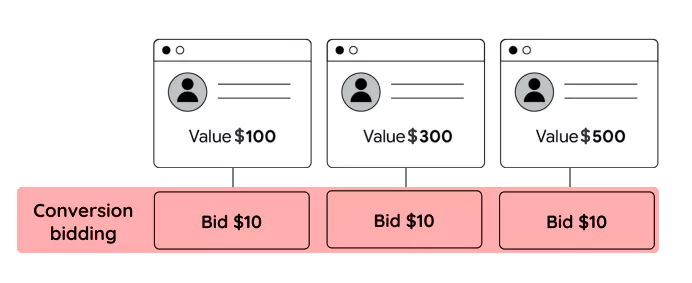
This is where the Maximize Conversion Value bidding strategy comes in.
How Maximize Conversion Value bidding Strategy works:
When you use the value based bidding strategy, the ad algorithm will work to achieve higher conversion value rather than higher number of conversions. The conversions are optimized for different values based on the conversion event happening in the real-time.
Every stage in your customers’ journey can have a different conversion value. You have to take that stage specific conversion value into account to bid on Google Ads effectively.
For example, a simple check out conversion might have a specific conversion value and is different from the conversion value of a subscribe event. Therefore, instead of bidding the same amount for all the conversions, the higher value conversions are bid higher.
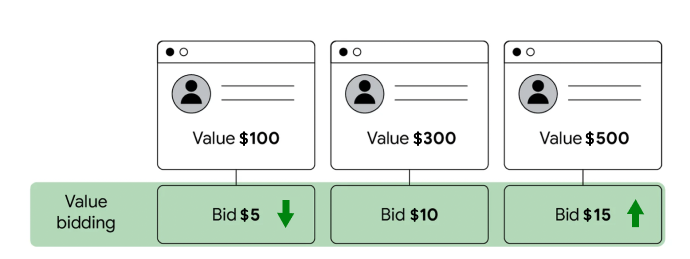
In the value based bidding strategy, you again have two options to choose from – 1. Maximize conversion value, & 2. tROAS or the target ROAS.
When you choose only the Maximize conversion value option but uncheck the tROAS, the algorithm will focus on spending your budgets to achieve higher conversion value only.
Whereas, when you also check the tROAS box and give a ROAS value, the Google Ads’ algorithm will focus on achieving the desired ROAS while achieving maximum conversion value.
Pro tip: In the initial stages, input the target ROAS lesser than the average ROAS you have achieved in the past. This will let the algorithm understand what ROAS it should optimize for and does not exhaust spending the budget quickly.
How to Setup Value Based Bidding?
First things first, let’s get started with setting up Conversion tracking for all the events you want to track. User’s actions that matter to you should be tracked to give you a clear picture of the users journey & how your bidding strategy is working.
If you want to manually track all the conversions, you can go with Google’s step by step guide to set up conversion tracking for your website. Alternatively, you can also use CustomerLabs’ No code event tracker to set up the conversion tracking for your website. Custom websites or built on platforms like WordPress, WooCommerce, Shopify, BigCommerce or any other platform, the No code event tracker works for all.
Conversions with monetary value:
Generally, the currency of the conversion value is the currency of your Google Ads billing account. However, if you have different currencies, you can set up your conversion currency in Google Analytics and then automatically the currency will be shown in the currency of your google ads billing currency.
Conversions without monetary value:
Let’s say you are running a free webinar and want to track the conversions that happen for people who click the ‘sign up for webinar’ button. For these conversions, you do not want to assign any monetary value because they do not bring in direct revenue. However, you need conversion values to be assigned to compare and measure relative performance of various conversion events. So, you have to simply enter the value, let’s say ‘4’ to register for the webinar and choose the “No currency set” option. This will show you the conversion value irrespective of the currency used.
Setting up the Conversion values:
Once the conversion tracking is setup, go through the following steps to set up the conversion value.
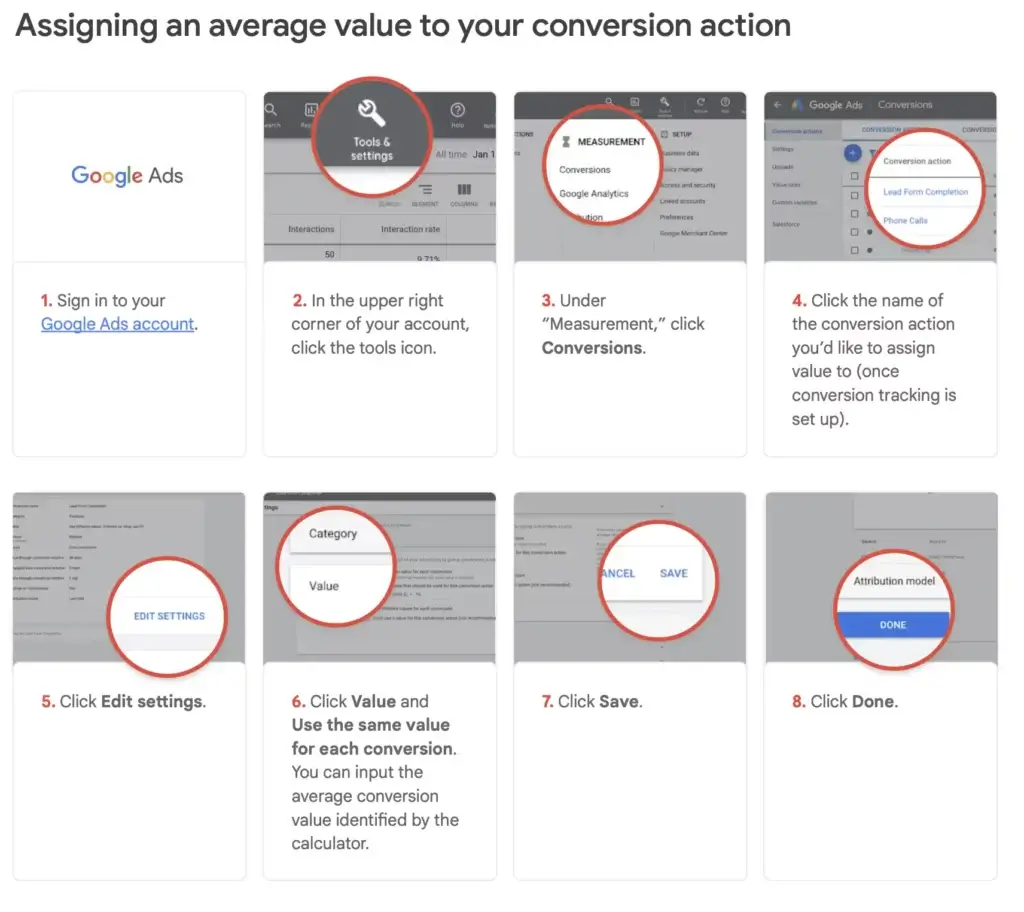
Here’s the catch. In the value, how do you assign the value? You find three options as below
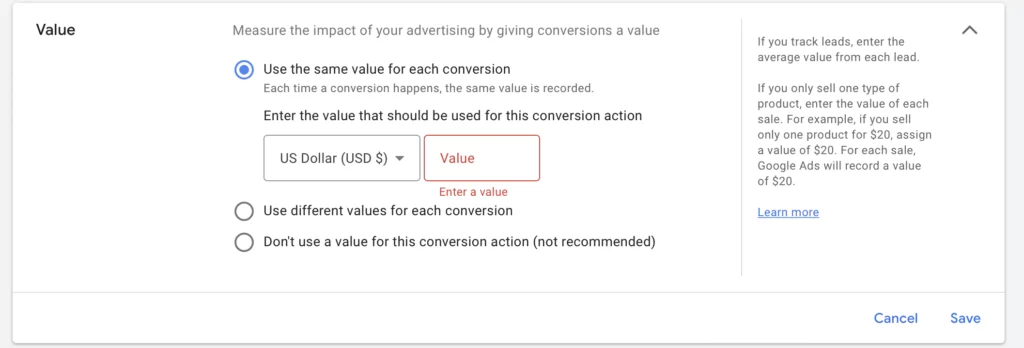
If you have the same value for every conversion, then go with the first one.
When you have more than one product with different values, and want to track the conversion value, use the second option. And when you use this, in the next step, it will ask you to give the specific conversion values for every product. You have to change the value in the code and place it on your pages on your website.
Now how do you calculate the conversion value? If there is only one product and all the conversion values are approximately the same, then you can use the conversion value calculator. [Refer to the Quick notes at the beginning of the blog under what is Value Based Bidding section]
Recommended if you have differential pricing: Use transaction-specific conversion values. You should setup your conversion tracking for every single differential pricing by copying the event snippet code by altering the currency value and currency code.
To use offline store conversions, you have to set up the store sales on your Google Ads account. And only then you should use the conversions from clicks using GCLID. After you do this, you should import the offline conversions.
Once you import them, you should bid for those actions that are close to the final purchase. This will help the algorithm to optimize for the higher conversion value, thus, adding more value from your ad campaigns.
Setting up Value based Bidding Strategy:
Next step to do after you set up conversion values is wait.
Yes, you heard it right. After you assign the values to all your conversion actions, you should wait for five to six weeks and valid conversions. Bookmark this blog link, add a reminder for six weeks to your google Calendar and come back to this blog again to continue. Lol, just kidding..
So, once the wait of six weeks is over, select any of the conversion values or target CPA bid strategy campaign to switch to value based bidding.
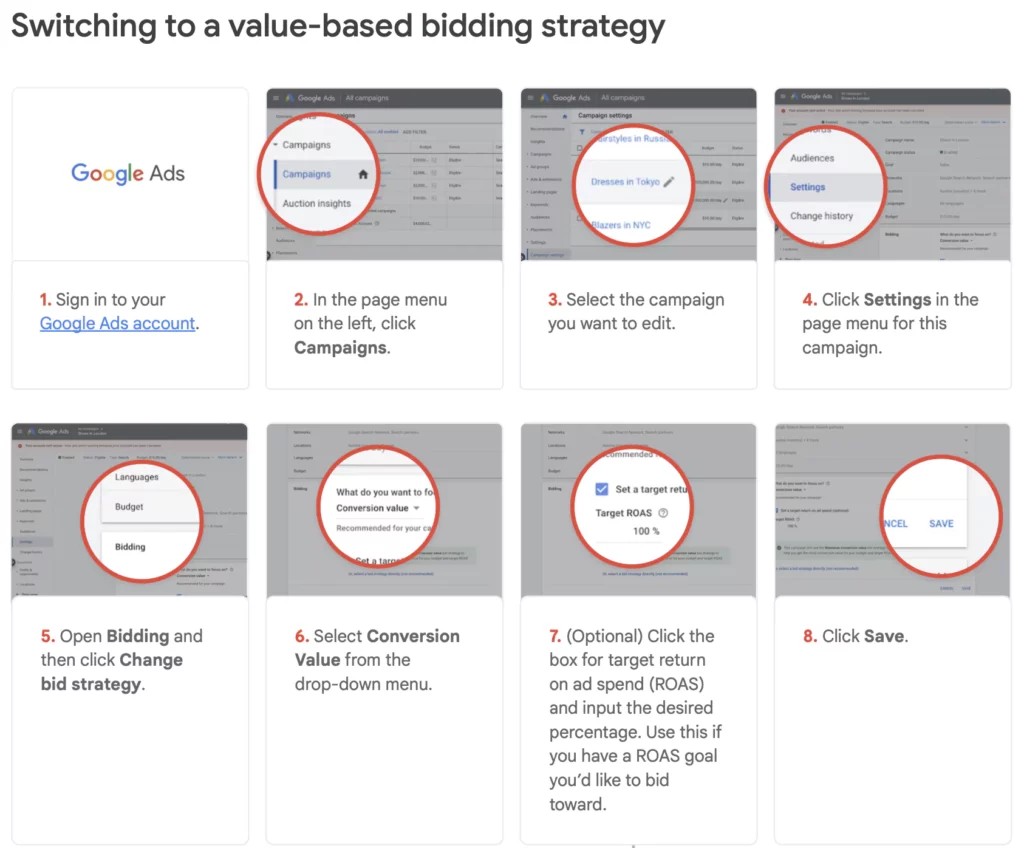
Change the bid strategy to Conversion value on Google Ads. Now, if you want to go with target ROAS, select the checkbox and give the ROAS value. The ROAS target you assign should be a little lower than your historical average ROAS value while you account for the delays in the conversions. The value in the column displaying conversion value / cost is the value you have to consider for tROAS.
Note: You will find the historical average ROAS in the bid strategy report. You can also set up portfolio bid strategy to share your budgets across campaigns.
Recommended Practices & Additional information:
In addition to what you do above, there are a few recommendations you have to keep in mind to leverage the full potential of value based bidding.
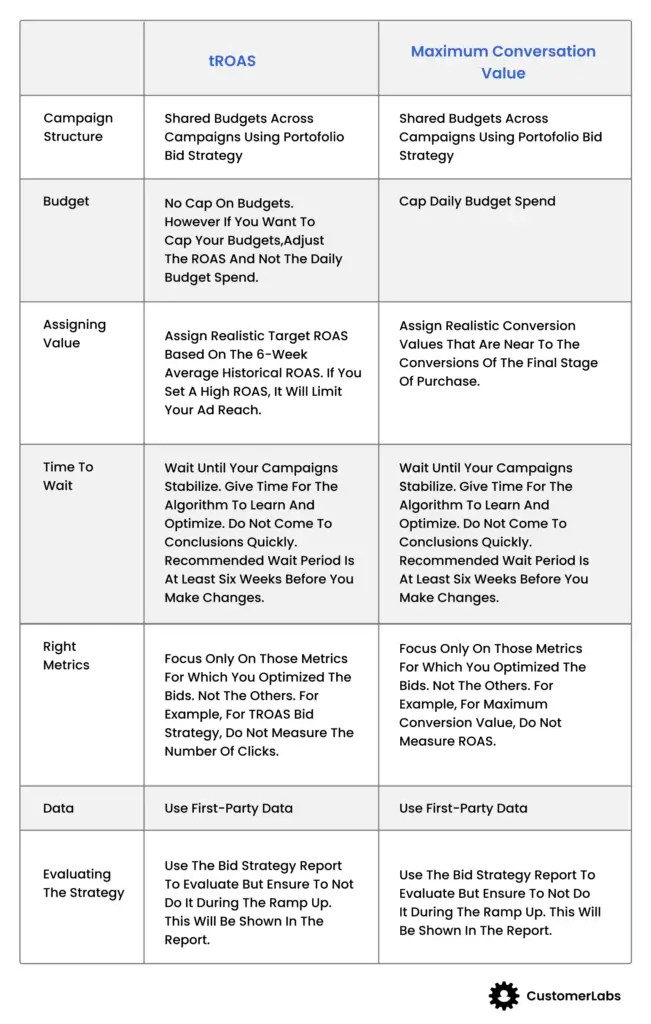
In short, below are the recommended best practices for value-based bidding:
- Robust Conversion Tracking and assigning the conversion value
- Simplified ad campaign structure
- Frequent testing of conversion tracking and ensure its intact
- Ensure to have a strong conversion history data before adopting value-based bidding
- Timely evaluation of Value Based Bidding campaigns to ensure profitability (POAS – Profit on Ad Spend)
- Have a achievable tROAS rather than being aggressive about it
- Be patient during the learning phase and do not disturb the campaign or analyze it.
- No budget caps at least during the learning phase.
- Almost near real-time conversion tracking to tackle conversion delays (Use CustomerLabs conversion tracking setup for Google Ads to deal with this)
- Do not forget to assign value to the conversions that matter to your business
- Measure only the right metrics.
- Before you start with the tROAS bid strategy you have to wait for a particular number of conversions to happen. They are as below:
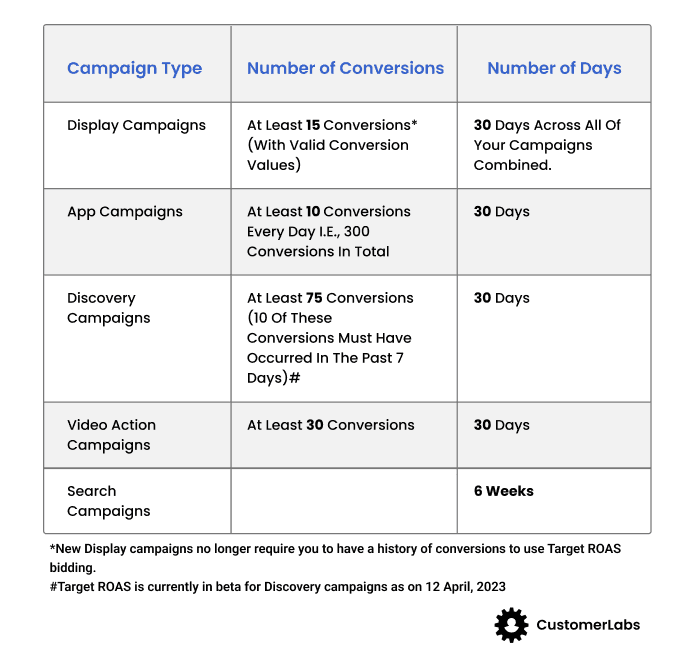
Latest Updates from Google’s AI Essentials on Value Based Bidding Best Practices
Google AI has recently launched a guide on how to optimize your value-based smart bidding strategy. Here are a few additional pointers from the same in addition to the few we already discussed in this blog such as – conversion tracking setup on the server-side.
- Connect all your first-party data (1P data) sources. CustomerLabs 1PD Ops platform helps you with it. Check out more about 1PD Ops here – The Ultimate Guide to 1PD Ops
- Leverage Google Enhanced conversions for increasing the accuracy of your conversions.
- Check out how Enhanced Conversions for web works to power your existing conversion tracking setup
- Enhanced conversions for leads also helps you to share your offline conversion data from CRMs, etc., to power your offline conversion tracking.
- Use data-driven attribution to map the entire customer journey. Tools like CustomerLabs 1PD Ops helps you map the customer journey accurately, giving you a comprehensive understanding about the importance of every single touchpoint. It goes a step further and gives you which channels helped in the decision making of your customer. Unveil the insights of your customer journey with multi-channel attribution – data-driven attribution.
- Ensure to bid on stages with low conversion frequency i.e., the quicker conversions. It is because you need at least 15 conversions a month.
- Google recommends daily upload of conversions (offline). But you can actually automate the entire offline conversion tracking to share the offline data in real-time with CustomerLabs powered Offline Conversion Tracking. To know more, talk to the experts.
- tROAS to be set as a balance between your KPI (the key goals you want to achieve) and the historical ROAS data.
- Start value-based bidding with a small-scale experiment and once you get a hold of it, eventually scale the campaign. But do not go huge.
- Keep the transition smooth to ensure better results
- At least have 3 conversion cycles (15 conversions per month a cycle) to evaluate or 2 weeks (according to Google)
How value based bidding works for businesses in various industries:
Value Based Bidding in Finance Industry:
Financial Institutions including banks have a huge opportunity to leverage value based bidding. Either to retarget the existing audience in the mid & bottom funnel or to target the top of the funnel audience. People who are searching for loans, credit cards, finance options, investment options, etc., and are in the top of the funnel (ToFu) audience. The ToFu can be targeted using search campaigns & other campaigns that find similar audiences.
Loans are the crucial assets for any financial institution and will try to increase their assets. If you are in the finance industry, run your ad campaigns using the value-based bidding strategy with First-party data.
Let’s understand the customer journey, touchpoints and then see how the value based bidding comes into play.
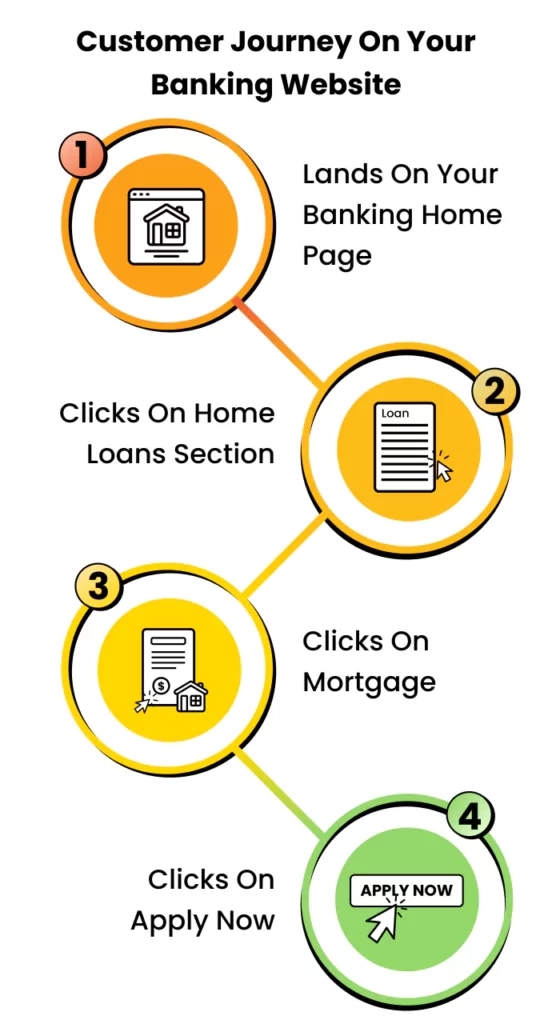
In this journey, the action closer to the final conversion is ‘apply now’. The other conversions like clicking on Home Loans on the home page, clicking on the Mortgage does not offer much value.
The value of lead for a customer clicking on Apply Now is $200. For this customer, the conversion value will be $16. How it is calculated is demonstrated below.
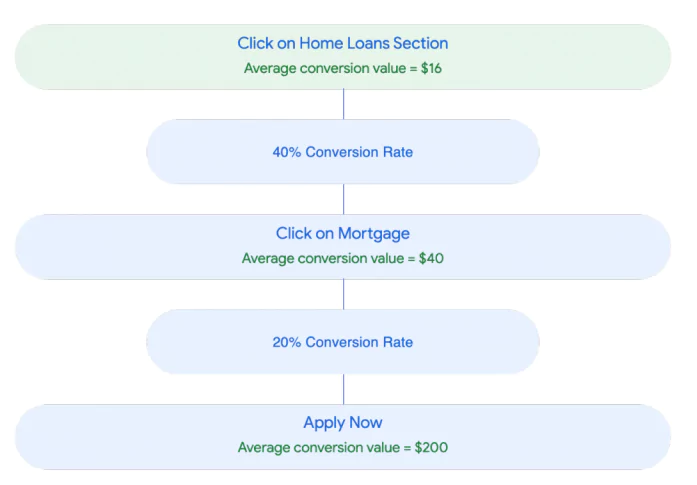
The conversion rate from the last step to the second step is 20% and from that to the first step is 40%.
20% of $200 is $40 and 40% of $40 is $16. So, the $200 traces down to the lead conversion value of $16. You have to input this lead conversion value to Google Ads.
In general, the customer might also visit the bank in-person. Then that also has to be mapped into the customer journey and the offline conversion data also is to be synced with Google.

Value Based Bidding in Fashion Industry:
If you are a fashion brand, you most probably by now have in-store (offline) and eCommerce (online D2C store) sales. Each and every product has a different pricing and different margin value and a different conversion value. Now, it will be meaningless if you simply assign the same conversion value for all the products and for all the conversions.
With value based bidding, you can actually bid for the transaction specific conversion values and therefore achieve higher profit margins rather than focussing on maximizing conversions.
Here’s how a typical customer journey looks for a eCommerce store
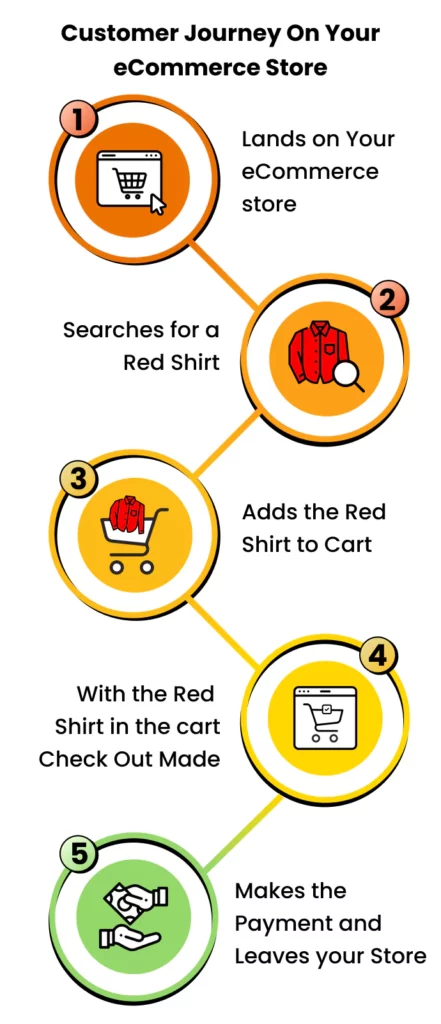
Now, let’s say the average cart value is $200. And for that, the lead conversion value that you should input to Google Ads is $3.7
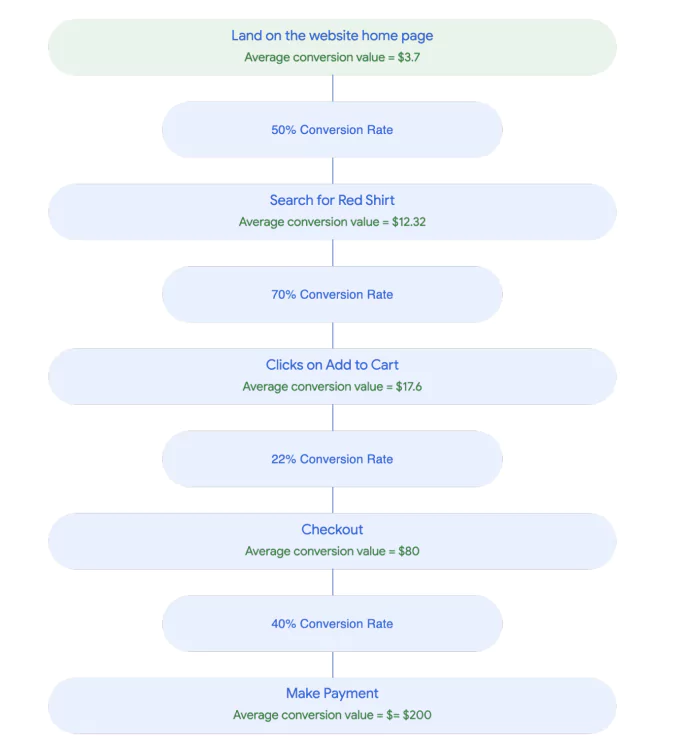
You can see how we have arrived at the $3.7 value as the average lead conversion value by understanding the customer journey.
Now, for every product, the final cart value will be different. Therefore, the conversion value also differs. Use the calculator to find the conversion value.
Therefore, you can segregate all your audiences and retarget them based on their value rather than targeting every single customer with the same ad spend. This is how you can leverage value based bidding for your eCommerce store.
Value based bidding for SaaS / B2B:
If you are running a B2B or SaaS business, you will have many conversions that need a value but in monetary terms, it actually does not add any value to your business.
Now, it does not make sense if you spend the same amount of money for both conversions as one brings in revenue while the other does not.
With value based bidding, you can specifically input the transaction specific conversion value to the ad platform and help the algorithm learn about the value for various conversions using the conversion tracking. Once you do this, the ad platform’s algorithm will run your ad campaigns very optimally by targeting the high value conversions.
Below can be the customer journey of a customer visiting your SaaS/B2B website.
Lands on the website home page > Click on Schedule Demo > Clicks on Sign Up
Now, below will be the conversion rate and conversion value for the customers going through this journey. Let’s assume that the final conversion value will be $150
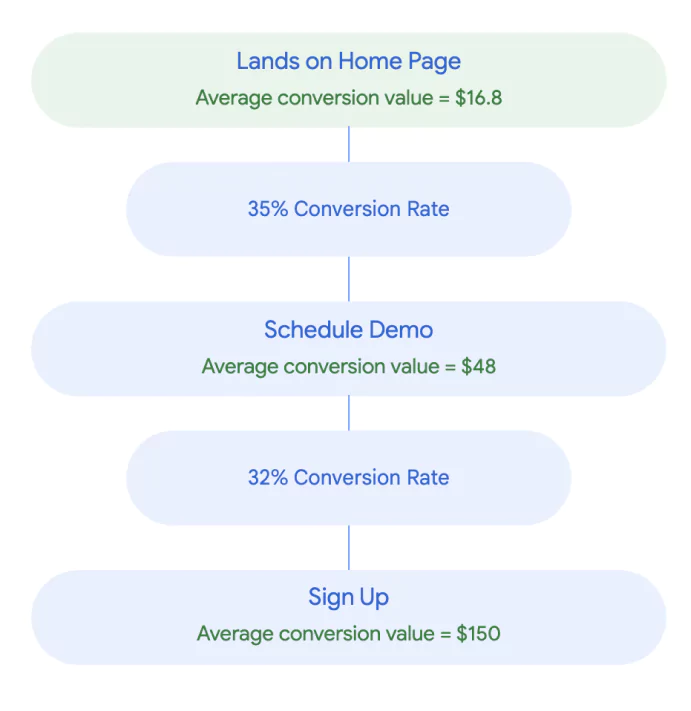
For the given conversion rates the conversion value that you have to input to Google Ads comes to around $16.8.
Therefore, as you have come up with the conversion value for people who land up on your home page. With this, you can come up with the optimal ad spend and make your SaaS/B2B business successful using value based biddin.
Key Takeaways:
Perfect Bid strategy: Be crystal clear on what bid strategy you want to use – Maximize conversion value or tROAS when you are going for a value based bidding strategy on Google Ads.
Clear Goal: Have one goal for your smart bidding strategy and work towards it. Do not confuse the algorithm and yourself. Smart biddings are devised to focus on one single objective and your job is to train the algorithm to achieve that objective with an optimized cost.
Input good audience signals: Sync audience signals without loss with the ad platforms. With third-party cookies going away and no more client-side tracking, it is better if you shift towards server-side tracking and collect your first party data.
First-party data: Give the ad platform first-party data of both known and anonymous users. Doing so will help the ad algorithm learn better to make your ad campaigns work better.
Train the algorithm: The ad platforms algorithms are like learners forever. You need to keep updating the algorithm with the data to help it learn better. That optimizes your ad campaigns better.
Overall, value based bidding proves to be an effective strategy to run your ad campaigns profitably by spending optimal amounts and gaining higher revenue with high value conversions.
Value based bidding is a bidding strategy that is beneficial for your business to take your ad campaigns to the next level. Following the recommended practices will definitely help you scale your value based bidding strategy based campaigns. Adopt the best practices such as a robust conversion tracking with tools like CustomerLabs’ server-side tracking, to ensure a successful ad campaign. Understand how Google’s ad algorithms work, and give them what they need. That will pave a way to your ad campaign success.

Some of the information used here in this blog are directly from Google
